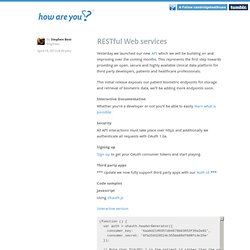

How are you? — RESTful Web services. Yesterday we launched our new API which we will be building on and improving over the coming months.

This represents the first step towards providing an open, secure and highly available clinical data platform for third party developers, patients and healthcare professionals. This initial release exposes our patient biometric endpoints for storage and retrieval of biometric data, we’ll be adding more endpoints soon. Interactive Documentation Whether you’re a developer or not you’ll be able to easily learn what is possible.
Security All API interactions must take place over https and additionally we authenticate all requests with OAuth 1.0a. Signing up Sign up to get your OAuth consumer tokens and start playing. Third party apps *** Update we now fully support third party apps with our Auth UI *** Code samples Javascript Using ohauth.js Interactive version Ruby Using Ruby OAuth. Best Practices for Designing a Pragmatic RESTful API. Your data model has started to stabilize and you're in a position to create a public API for your web app.

You realize it's hard to make significant changes to your API once it's released and want to get as much right as possible up front. Now, the internet has no shortage on opinions on API design. But, since there's no one widely adopted standard that works in all cases, you're left with a bunch of choices: What formats should you accept? How should you authenticate? Should your API be versioned? In designing an API for SupportFu (a Zendesk Alternative), I've tried to come up with pragmatic answers to these questions. ... or just skip to the bottom and signup for updates Key requirements for the API Many of the API design opinions found on the web are academic discussions revolving around subjective interpretations of fuzzy standards as opposed to what makes sense in the real world.
Use RESTful URLs and actions If there's one thing that has gained wide adoption, it's RESTful principles. Best Practices for Designing a Pragmatic RESTful API. REST and JSON best practices. For a long time I've been struggling with REST API conventions.

REST was -and is- a difficult concept which has been poorly understood for a long time. Nowadays there are lots of excellent style guides. Below I've gathered some guidelines and best practices from various sources. In all guidelines I've assumed the REST service returns JSON because it is the most common format these days. Most guidelines should work for other formats (XML in particular) as well. HTTP methods The collection must be in plural, /users/bob... instead of /user/bob...If you need to do something that may yield different results if you call it multiple times after each other (i.e. the service is not idempotent) use POST.GET and DELETE do what you think they do.POST and PUT might not do what you think they do.
HTTP result codes The following list contains the more relevant REST-service HTTP status codes. A common mistake is to return a 200 OK when something went wrong. URL format. JSend. What?

- Put simply, JSend is a specification that lays down some rules for how JSON responses from web servers should be formatted. JSend focuses on application-level (as opposed to protocol- or transport-level) messaging which makes it ideal for use in REST-style applications and APIs. Why? - There are lots of web services out there providing JSON data, and each has its own way of formatting responses. Also, developers writing for JavaScript? So how's it work? A basic JSend-compliant response is as simple as this: When setting up a JSON API, you'll have all kinds of different types of calls and responses. Example response types ¶ Success: When an API call is successful, the JSend object is used as a simple envelope for the results, using the data key, as in the following: GET /posts.json: GET /posts/2.json:
Home · wordnik/swagger-core Wiki. Docs - API REST Response. Response Formats Twilio can respond to your requests with various formats.

The most common are detailed below. For special cases and extra formats see the Tips & Tricks section. By default, Twilio's REST API returns XML, with a root element of <TwilioResponse>. For example, here is the default XML representation of a SMS message: GET /2010-04-01/Accounts/AC228b9... Twilio also supports returning resource representations as JSON. GET /2010-04-01/Accounts/AC228b9... Other Twilio can also return CSV, HTML and other response types. Exceptions Twilio returns exceptions in the HTTP response body when something goes wrong. If you receive an exception with status code 400 (invalid request), the 'Code' and 'MoreInfo' properties are useful for debugging what went wrong.
Examples Example 1 Here is a simple 404: Example 2 An invalid POST to the Calls resource without a 'To' parameter would return: One of the core principles of REST is "Hypermedia As The Engine Of Application State. " List Resources. Tasklists: list - Google Tasks API.